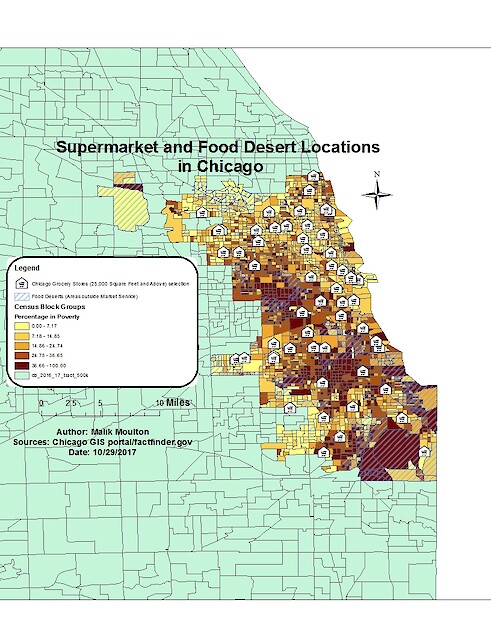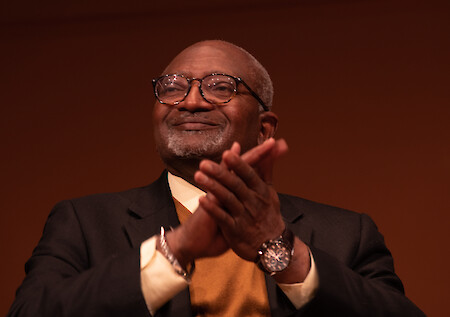Food Deserts: The Fight for Social Equity
Nicholas Dawson ·Take out your phone, click on apple maps and type in a grocery store. You will probably see the farthest grocery store from your current location is within a mile. Now imagine that you lack the ability to access your grocery store which contains a surplus of nutritional produce. Your only options are to depend upon fast-food chains and convenience stores. Sounds rather unfavorable and highly unsatisfactory. Unfortunately, this is a reality in which approximately 19 million people are not able to escape. The USDA describes this reality as a food desert; in which individuals, specifically those of low-income and colored communities, live more than a mile from supermarkets located in urban areas and more than ten miles in rural areas.

This week’s topic of discussion in our Environment and Society class was Environmental Justice. The EPA defines Environmental Justice (EJ) as the “ fair treatment and meaningful involvement of all people regardless of race, ethnicity, income, national origin, or education level in the development, implementation, and enforcement of environmental law, regulation, and policies. The environmental movement was started and created by communities that consisted primarily of people of color, that sought to communicate the various environmental injustices in their communities. Though it was unsuccessful, the sit-in against PCB landfill pollution in Warren County, North Carolina, is seen as the catalyst that spurred the environmental justice movement into action. Bullard (1993), also known as the Father of Environmental Justice, wrote “whether, by conscious design or institutional neglect, communities of color in urban ghettos, in rural 'poverty pockets', or on economically impoverished Native-American reservations face some of the worst environmental devastations in the nation¹”.

I drew my inspiration to write this blog from my own personal experiences. I have lived in areas that are known as food deserts. There was a time in my life where my family and I weren’t at the socio-economic level we are today. In fact, it was easier to obtain a cheeseburger from McDonald’s than it was to acquire food that had nutritional value. Fast-food chains were strategically placed in colored and low-income communities. Obesity, diabetes, and cardiovascular rates have a high prevalence in low-income and minority communities because of access to fast-food outlets². One would think all citizens deserve the right to healthy food options. Yet, this is clearly not the case. I distinctly remember how perishables found in convenient stores within food deserts cost more than the ones found in grocery stores in urbanized areas. This long history of oppression combined with an increase in economic disparities created locations that are stricken with poverty and allowed the creation of food deserts³. In fact, you potentially won’t see the construction of Whole Foods, a grocery store that contains healthy and nutritious food, in a low-income colored community. Grocery stores like that are primarily catered to individuals that live in high areas of wealth.

Urban food deserts, areas that still consist of racial segregation, income inequality, and extremely limited access to nutritional food need to be reformed¹. Improving public transportation such as buses and Ubers, for example, would increase communities' access to healthier product options. Incentivizing mainstream food corporations to move and build within poverty-stricken communities². Engaging in grassroots organizations that focus on food justice activism in colored and low-income communities⁴. Just Food, located in New York City, works to bring communities access to both safe and affordable food. They work with local farmers to ensure there is sustainable food regardless of socioeconomic status. In Baltimore, food deserts, now called Healthy Food Priority Area, consist of communities of thirty-one percent black individuals. The Black Food Sovereignty Coalition works as a central location for colored communities to battle barriers that hinder our access to food and economic opportunities. The BFSC has made movements in Baltimore, in which they promote progressive governance for communities to grow their own produce. Looking back at history, enslaved black communities were inevitably forced to tend to the land, yet had been excluded from ever owning it. Baltimore serves as an incredible example in which black farmers are able to cultivate crops in empty lots. More so, the Black Vegetarian Society of Maryland is an organization that focuses on increasing access to both nutritional education and promoting plant-based diets within colored communities.

I know that environmental justice will one day remove the concept of food deserts within communities. Food insecurity is getting more attention within low-economic and colored communities. Black-owned businesses and innovative farming opportunities are allowing for the production and sharing of food between colored and low socioeconomic communities. Moreover, with the signing of President Biden’s Executive Order, in which one aspect aims to uphold Environmental Justice in America, (EJ) activists have high hopes for the future generations.
References
- Alkon, A. H., & Agyeman, J. (Eds.). (2011). Cultivating food justice: Race, class, and sustainability. MIT press.
- Bullard, R. D. (Ed.). (1993). Confronting environmental racism: Voices from the grassroots. South End Press.
- Hilmers, A., Hilmers, D. C., & Dave, J. (2012). Neighborhood disparities in access to healthy foods and their effects on environmental justice. American journal of public health, 102(9), 1644-1654.
- Tobin, B., & Weaver, B. L. Health and Socioeconomic Disparities of Food Deserts.
About the author
Nicholas Dawson

Nicholas Dawson is a first year PhD student in the Environment and Society foundation. His research interests are in microplastic pollution and the effects it has on aquatic organisms and on socio economic level.
Next Post > My Introduction to Chesapeake Bay
Comments
-
Yanyu Wang 4 years ago
Hi Nick!
Thanks for the great blog! I love the flow of the article by starting with the explanation of the food desert and connecting with your personal experience. I am very delighted to see the appearance of Just Food, as a way to bring affordable and safe food for local underrepresented communities and progressive governance of the black community is also emerging. Also, during the pandemic, some apps such as Instacart is emerging which provides the grocery delivery service if you hesitate to go out and contact people, I use that pretty often currently because I am not super proficient at driving but living in Frostburg is kind of far away from the grocery stores, but using this service requires a membership fee up to $99 per year, which is a little pricy. In short, I am very pleased with the emergence of these services. After all, it solves the problem of distance, but the relatively high cost also discourages many people. I hope that there will be more attempts to solve the problem of food desert in the future. -
Bill Dennison 4 years ago
Nick, Your blog focus on food deserts was not a topic that we explored in the Environmental Justice class that Dr. Vanessa Vargas-Nguyen introduced during class, so I am glad that you have added this dimension to the discussion. I know that several professors and graduate students in the Department of Anthropology, University of Maryland are focused on food deserts. I learned at a graduate student forum that even the Univ. of Maryland main campus was considered a food desert, because grocery stories were distant and difficult to access via public transportation and the plentiful campus food was for pretty much for students in dorms or expensive restaurants. That realization stimulated the creation of the food co-op on campus. It seems that food deserts are only recently recognized by people unaffected by this form of injustice, so I am glad that you feature this issue. Well done.
-
Barry Bowman 4 years ago
Very informative Nick!
I appreciate how you tied in our discussion about food availability to your own past experiences. I primarily make my own meals from scratch, so not having access to stores with fresh produce would dramatically hinder my ability to have a healthy diet. In that context, I like your inclusion of urban farming, too. Even in my apartment, I am able to grow usable plants like basil, kale, and aloe with very little effort. If more people can get behind growing food instead of grass or ornamental plants, I believe this could act as a stepping stone to change more broad public perceptions about how patches of earth are utilized. For example, instead of bradford pear trees, people could plant trees that would produce edible fruits!
I wonder too, that if people grew more fresh produce at home and in their communities, if the supply chain for these foods in grocery stores would change.
A very thought provoking blog! -
Shuyu Jin 4 years ago
Hi Nick! I appreciate your blog. A food desert is indeed one of the most typical environmental justice cases, especially the current American society, which is a microcosm.
When I first came to the United States, the most considerable inconvenience was getting to the grocery store nearby, even though I lived near College Park. There is no convenient public transportation, and the contrast with China's ubiquitous shops is stark. Geographical location, people gathering, and other factors do affect grocery distribution.
Another discovery is what you mentioned in your blog. The aggregation of junk food/fast food in the low-economic and colored communities is apparent. To some extent, it aggravates the health problem of obesity among low-income groups in the United States, which is a vicious cycle. How to make healthy and convenient food available to all groups is a long-term social problem. -
Nicole Holmes 4 years ago
Nick Dawson! My Man!
This was great! As someone that has not known this type of hardship to the same degree, your presentation only puts more fuel in my fire for EJ. The fact that you can consistently draw personal connection to this and many other class topics related to unequitable treatment of people is bittersweet. It informs an encourages us to keep fighting for our brothers and sisters, but also hurts the heart to hear that you had to go through these hardships to have such an understanding and connection. The more we talk about these things in a personal light, the more people like me (who didn't have a grasp on this issue previously) will have opportunities to expose themselves to societal issues that go unseen or uncared for by the majority population. I look forward to seeing you blossom more as a future world leader!
Nicole
-
Imani Black 4 years ago
Nick!!!!!!
I already knew that you were going to kill this blog and you did not disappoint! It was so inspiring right from the beginning! Getting people to realize just how lucky they are (myself included) is key when addressing these issues so they have thought provoking changes. I include myself in this because I didn't grow up in a food desert and it wasn't until I started diving into EJ work and my nonprofit that I realized how big of an issue food security and food injustice really is. How do we expect communities, especially younger generations, to grow into impactful leaders if they don't have the proper nutrition to simply get through their day? I hope this issue continuous to grow in our conversations until we can find long lasting solutions to truly help these communities. Thanks for sharing your experiences!
-
Matt Kusche 4 years ago
Nick,
I really loved your blog regarding food deserts. As someone who has actually lived in several areas that would classify as food deserts, I understand and can relate to the fact it is easier to find fast food than actual supermarkets that contain actual nutritional value. I love the fact that you bring in your own personal experience and really love into depth the prevalence regarding food deserts. I know when I first learned about food deserts, I was just starting in college and found it to be a foreign concept that was relatively hard to grasp in regard to how such a place could actually exist. A few years later, I can totally understand and realize the hardship associated with such localities and how the average person is practically forced to not eat in a healthyanner. Thanks for bringing this subject to light!
-
Jana Hana Kopelent-Rehak 4 years ago
Nick, a very important topic and close to home for me. I relate to your topics based on my own 25+ years of engagement when teaching urban applied anthropology in collaboration with people and organizations from underprivileged communities in Baltimore. I like how you go from national to local, zooming in and showing specific local gardening. I think you may like to see urban anthro-geography by David Harvey, mostly related to Baltimore. Hope for the City or Rebel City are two books he wrote, among many, under the influence of Henry Lefebre - French Urban Sociologist and Philosopher. Another name that comes to mind is Jane Jacobs, an urban socioeconomist. What is interesting to me about Baltimore is how in many parts of East and West, gardens and food pantries are attached to the churches. Some have multiple purposes, such as one near McElderry St.https://www.facebook.com/watch/?v=1840838412757307 or https://naturesacred.org/sacred_place/amazing-grace-evangelical-lutheran-church/
and another interesting aspect of community gardening in Baltimore is how food growing is also connected to art-making, community art, and public art or events such as concerts. https://baltimoregreenspace.org/500-north-duncan-street-community-garden/ Drawing from Harvey, I see it very much as a form of reclaiming the city from grassroots.
And then there is a tradition I referred to in class, Arabbers - food street selling while singing/poetry: https://en.wikipedia.org/wiki/ArabberYou bring many memories back for me. with your blog, Thank you!

